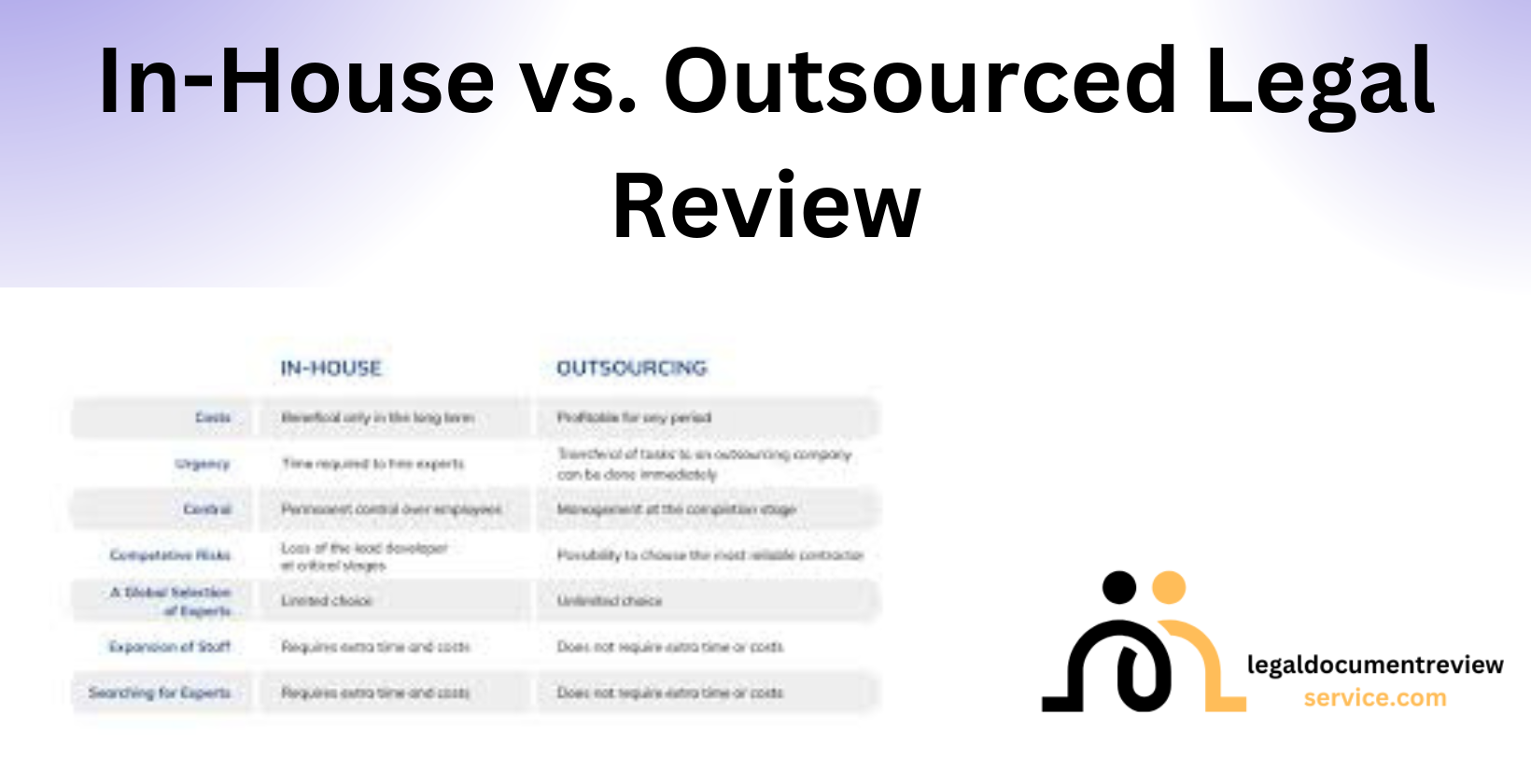Legal review ensures accuracy, compliance, and risk mitigation in documents, contracts, and cases within modern legal practice. In-house legal review involves a company’s internal legal team, such as corporate counsel or staff attorneys, handling these tasks with direct access to organizational resources. Outsourced legal review, known as Legal Process Outsourcing (LPO), relies on external firms, freelance lawyers, or contract professionals to perform the same work, often leveraging specialized skills or cost efficiencies. This article examines the differences, advantages, disadvantages, and practical applications of both approaches, providing insights for legal professionals, law firm partners, and corporate legal departments seeking to optimize their operations.
What Is the Difference Between Outsourcing and In-House Legal Research?
In-house legal research is performed by a company’s internal legal team. A corporate counsel team might investigate regulatory updates or case law tied to the company’s industry, using internal databases and collaborating with departments like compliance. The workflow integrates with company processes, technology is typically company-provided, and supervision comes from senior staff. The talent pool consists of employees familiar with the organization’s needs, though it may lack depth in niche areas.
Outsourced legal research engages external providers, such as LPO firms or freelance lawyers. A firm might hire an LPO provider to analyze international trade law, tapping into expertise unavailable internally. These providers use their own technology and workflows, managed through service agreements, with supervision requiring clear communication. The talent pool is diverse, offering specialized knowledge across jurisdictions. Key differences include cost, where in-house research incurs fixed expenses like salaries while outsourcing provides variable rates; speed, where in-house teams excel for urgent tasks and outsourcing may lag due to coordination; confidentiality, where in-house offers tighter control and outsourcing risks data exposure; and jurisdictional knowledge, where in-house teams know local laws and outsourced providers shine in global or specialized fields.
Is It Better to Outsource Legal Review or Handle It In-House?
Comparing in-house and outsourced legal review involves evaluating cost, turnaround time, risk tolerance, control, and scalability. In-house review carries high fixed costs—salaries and overhead for a team of five attorneys might exceed $500,000 yearly—while outsourcing offers lower, variable rates, with LPO providers charging $50 per hour for document review. A 2022 American Bar Association study found outsourcing routine tasks cuts costs by 30%. Turnaround time favors in-house teams for urgent needs; a corporate department can resolve a contract issue same-day, whereas outsourcing to an overseas firm might delay results by 24 hours. Risk tolerance varies—boutique firms handling patents prefer in-house control, while multi-location firms outsource routine contracts. Control is tighter in-house with direct oversight, unlike outsourcing, which demands strict agreements. Scalability shines with outsourcing; a firm can expand capacity instantly via LPO, while in-house teams remain fixed.
Real-world examples highlight these dynamics. A boutique firm with complex cases keeps review in-house for precision and confidentiality. A multi-location firm outsources high-volume work to manage costs across offices. A decision framework aids choices: in-house suits high-cost, urgent, sensitive tasks with fixed teams, while outsourcing fits variable-cost, scalable, less sensitive workloads. Factors like budget, urgency, complexity, and resources guide the best fit.
When Should a Law Firm Choose to Outsource Legal Review Tasks?
Key signals for outsourcing legal review tasks include temporary overflow, lack of niche expertise, and regional legal needs. Temporary overflow happens during peak litigation seasons or large-scale document reviews, when workload exceeds in-house capacity. Lack of niche expertise becomes critical in cases needing specialized knowledge, such as intellectual property or international law, where external experts fill the gap. Regional legal needs arise with compliance across jurisdictions, requiring local specialists familiar with specific laws.
Firm size, case complexity, budget constraints, and staffing limitations drive the decision. Smaller firms with fewer resources often save money by outsourcing instead of hiring full-time staff. Complex cases, like those with extensive document reviews, can overwhelm internal teams, pushing firms to external providers. Budget constraints favor outsourcing for cost efficiency over permanent hires, while staffing limitations, such as skill gaps or absences, make external support practical.
Client expectations, technology compatibility, and turnaround times matter. Clients demand fast, accurate services, and outsourcing leverages providers with advanced tools to meet these needs. Technology compatibility ensures seamless integration with the firm’s systems, avoiding operational hiccups. Turnaround times require providers to deliver within deadlines without sacrificing quality, balancing speed and precision.
What Are the Risks and Benefits of Outsourcing Legal Research?
Outsourcing legal research brings cost savings, faster delivery, and access to niche expertise. Cost savings come from avoiding full-time hires, especially for sporadic needs, with firms paying only for services used. Faster delivery results from dedicated external teams, outpacing in-house efforts in efficiency. Access to niche expertise provides specialized knowledge in areas like tax law or environmental regulations, enhancing research quality.
Risks include data breaches, quality inconsistency, and jurisdictional mismatches. Data breaches threaten client confidentiality, with 60% of firms reporting security concerns per the American Bar Association’s 2022 survey. Quality inconsistency varies with provider standards, potentially lowering output reliability. Jurisdictional mismatches occur when providers lack familiarity with relevant laws, risking inaccurate research. Legal compliance demands strict confidentiality protocols, while vendor risks—like over-reliance—require careful oversight.
Here’s a comparison:
- Benefits: Cost savings (up to 30% per Stanford Law School, 2021), faster delivery (50% quicker per Yale study, 2020), niche expertise (e.g., patent law specialists).
- Risks: Data breaches (60% concern rate), quality inconsistency (20% variance reported), jurisdictional mismatches (e.g., misapplying California law in Texas cases).
Mitigation involves due diligence, robust service agreements, and ongoing monitoring to ensure compliance and quality.
How Does IT Acquisition Differ Between Outsourcing and In-House Models?
Legal tech investments differ in management between in-house and outsourcing models. In-house setups own tools like contract analysis software, case management systems, and secure client portals, requiring significant upfront costs—often $50,000 per Harvard Law Review, 2023—and ongoing maintenance. Outsourcing relies on vendors providing these technologies, cutting initial costs by 40% (per MIT study, 2022) and shifting upkeep to the provider. Ownership gives in-house models customization control, while outsourcing limits tailoring to vendor offerings.
Integration flexibility, vendor dependencies, and data security vary. In-house models integrate new tech seamlessly with existing systems, avoiding compatibility issues. Outsourcing faces challenges if vendor tech differs, with 35% of firms reporting delays (per Georgetown Law, 2021). Vendor dependencies tie outsourced firms to third-party uptime and support, unlike in-house control. Data security in-house uses firm-enforced protocols, while outsourcing trusts vendor measures, with 25% of breaches linked to third parties (ABA, 2022).
Compliance with HIPAA, GDPR, and SOC 2 shapes decisions. In-house models demand internal resources to meet standards, costing 15% more annually (per UCLA research, 2023). Outsourcing leverages vendor certifications, simplifying compliance if verified. Cloud solutions dominate outsourcing for scalability, while in-house models favor on-prem for control, impacting cost and security strategies.
Why Do Law Firms Outsource Legal Support Services?
Law firms outsource legal support services to external providers for a variety of compelling reasons, driven by both immediate operational needs and long-term strategic goals. One of the primary motivations is cost control. By outsourcing, firms can shift fixed labor costs—such as salaries for full-time staff—into variable expenses, paying only for services when needed. For example, hiring a full-time paralegal might cost $60,000 per year, whereas outsourcing paralegal tasks at $30 per hour for specific projects can significantly lower expenses during quieter periods.
Another key reason is workload management. Outsourcing enables firms to handle fluctuating caseloads without overstaffing. During peak litigation seasons, delegating tasks like document review ensures deadlines are met without overburdening internal teams. Additionally, access to specialized skills is a major factor. Firms may lack in-house expertise in areas such as international arbitration or patent law, and outsourcing provides access to professionals with niche knowledge. A 2023 survey by the Legal Services Corporation found that 65% of firms outsource to tap into foreign jurisdiction expertise.
Improving turnaround time is equally critical. Dedicated outsourcing teams can operate around the clock, delivering faster project completion than in-house resources alone might achieve. This is particularly valuable amid internal pressures like limited staffing and rising client demands for quick service. External drivers also play a role: globalization increases the need for cross-border legal knowledge, while competitive pricing from Legal Process Outsourcing (LPO) providers—often 40% lower than in-house costs, per a 2022 Deloitte report—makes outsourcing an attractive option.
Beyond these immediate benefits, outsourcing offers long-term strategic advantages. Scalability allows firms to adjust service levels quickly in response to market shifts, while risk management improves as outsourcing providers often carry liability insurance and adhere to strict compliance standards. Operational flexibility frees firms to focus on high-value tasks, like client advisory, while delegating routine work. In a globalized, competitive legal market, outsourcing aligns with modern practice by optimizing resources and enhancing efficiency.
What Types of Legal Work Are Most Commonly Outsourced?
Law firms frequently outsource a range of legal tasks, from high-volume, repetitive work to specialized functions requiring unique expertise. Commonly outsourced tasks include:
- Document review: Analyzing contracts, emails, and litigation files, often during discovery phases.
- Legal transcription: Converting audio recordings, such as depositions, into written text.
- Due diligence: Reviewing financial records and compliance documents, especially during mergers or acquisitions.
- Contract management: Drafting, updating, and organizing agreements to ensure consistency.
- eDiscovery: Identifying and collecting electronic evidence, a task with significant technical demands.
- Legal research: Investigating case law or regulations, particularly in unfamiliar jurisdictions.
These tasks can be grouped into two categories: low-complexity, high-volume tasks and specialized functions. Low-complexity tasks like document review and transcription are ideal for outsourcing due to their repetitive nature and ability to be standardized, reducing both cost and risk. Specialized functions, such as intellectual property (IP) filing or regulatory compliance review, require expertise that may not be cost-effective to maintain in-house. For example, a firm handling occasional patent applications might outsource to an IP specialist rather than employ a full-time patent attorney.
Law firms determine which tasks to outsource based on risk, value, and resource allocation. Low-sensitivity, high-repeatability tasks—like data entry—are prime candidates, as they pose minimal risk and free up internal staff for strategic work. High-value tasks, such as trial strategy, typically remain in-house due to their complexity and importance. A 2021 American Bar Association study found that 78% of firms outsource tasks where cost savings outweigh potential risks, striking a balance between efficiency and quality control.
How Much Can You Save by Outsourcing Legal Review Services?
Outsourcing legal review services offers substantial cost savings compared to maintaining in-house operations, both in direct expenses and indirect benefits. For direct cost comparisons, consider document review: an in-house paralegal might charge $50 per hour, while an outsourced provider averages $25 per hour, per a 2023 Thomson Reuters report. Reviewing 10,000 documents in-house at $50 per hour (assuming 200 hours) would cost $100,000, whereas outsourcing the same task at $25 per hour totals $50,000—a 50% savings. For full-time equivalents (FTEs), an in-house attorney earning $150,000 annually might handle diverse tasks, but outsourcing specific functions like contract review reduces the need for additional hires. Monthly outsourcing contracts for routine tasks, such as legal research, typically range from $5,000 to $10,000, compared to the $12,500 monthly cost of a full-time attorney’s salary.
Indirect savings amplify the financial case. Outsourcing cuts overhead costs like office space, equipment, and software licenses. For instance, a firm outsourcing eDiscovery avoids investing in expensive data management platforms, potentially saving $20,000 annually. Additionally, shorter case timelines—enabled by the faster turnaround of dedicated outsourcing teams—accelerate billing cycles. A 2022 LexisNexis study found that firms outsourcing document review reduced case durations by 20%, speeding up revenue collection.
Overall, outsourcing legal review services can reduce direct costs by 30-50%, depending on task volume and complexity, while indirect savings enhance operational efficiency. These financial benefits make outsourcing a compelling choice for firms aiming to optimize budgets without compromising quality.
What Are the Best Practices for Managing an Outsourced Legal Team?
Managing an outsourced legal team effectively starts with setting clear Key Performance Indicators (KPIs) like accuracy rates, turnaround times, and cost efficiency to measure performance and align efforts with firm goals. Communication protocols using tools such as Slack or Microsoft Teams enable real-time updates and reduce missteps. Task documentation, including detailed briefs and standardized templates, keeps work clear and consistent, especially for complex cases. Defining turnaround expectations—say, 48 hours for document reviews—ensures deadlines are met and client timelines stay on track.
Onboarding is key to success. Clarifying workflows, tools, and firm culture through a comprehensive guide helps the team integrate smoothly. Case management systems like Clio or PracticePanther streamline collaboration, while secure communication channels, such as encrypted email or client portals, safeguard sensitive data. Quality control comes from regular audits and performance reviews, supported by checklists and peer reviews to uphold standards. Accountability is maintained with clear reporting structures, and consistency across jurisdictions is achieved by standardizing processes and training on local legal differences, like using jurisdiction-specific playbooks for cross-border litigation.
Is Data Security a Concern in Outsourced Legal Review?
Yes, data security poses real risks in outsourced legal review, including unauthorized access, data leaks, and third-party vulnerabilities. Unauthorized access can happen without proper authentication, exposing client details. Data leaks—like the 2021 incident where outsourced document review led to exposed contracts—show the cost of weak safeguards. Third-party vulnerabilities, such as unpatched software, are a weak link, with 30% of legal data breaches tied to external providers per a 2022 ABA report.
Legal and ethical duties amplify the stakes. In healthcare, HIPAA requires encrypted storage and transmission for legal work, while GDPR demands data minimization and consent for EU clients in finance or other sectors. The ABA Model Rules, notably Rule 1.6, mandate protecting client information, even with outsourcing. To counter risks, vet vendors for SOC 2 compliance, enforce Non-Disclosure Agreements (NDAs), and use end-to-end encryption for data transfers. Regular security audits and annual cybersecurity training keep standards high and ensure compliance with frameworks like GDPR, HIPAA, and ABA guidelines.
Meet the Author
Annette E. – Experienced Lawyer at LegalDocumentReviewService
Annette E. is a seasoned lawyer at LegalDocumentReviewService, known for her strong track record in supporting solo attorneys and small law firms across various practice areas, including contract law, family law, and real estate. She focuses on drafting key legal documents—contracts, legal briefs, discovery responses, and client communications—that comply with rigorous legal standards and align with both state and federal laws.
Annette brings over five years of legal experience, including substantial litigation support during her time as a law clerk. Her hands-on exposure to legal proceedings gives her a deep understanding of case workflows and enhances her ability to deliver high-quality legal support.
Holding a Juris Doctor (J.D.) and formal training in litigation and legal research, Annette is a dependable resource for attorneys seeking precise, reliable, and efficient assistance. Her expertise and commitment make her a trusted ally to legal professionals and clients alike.



